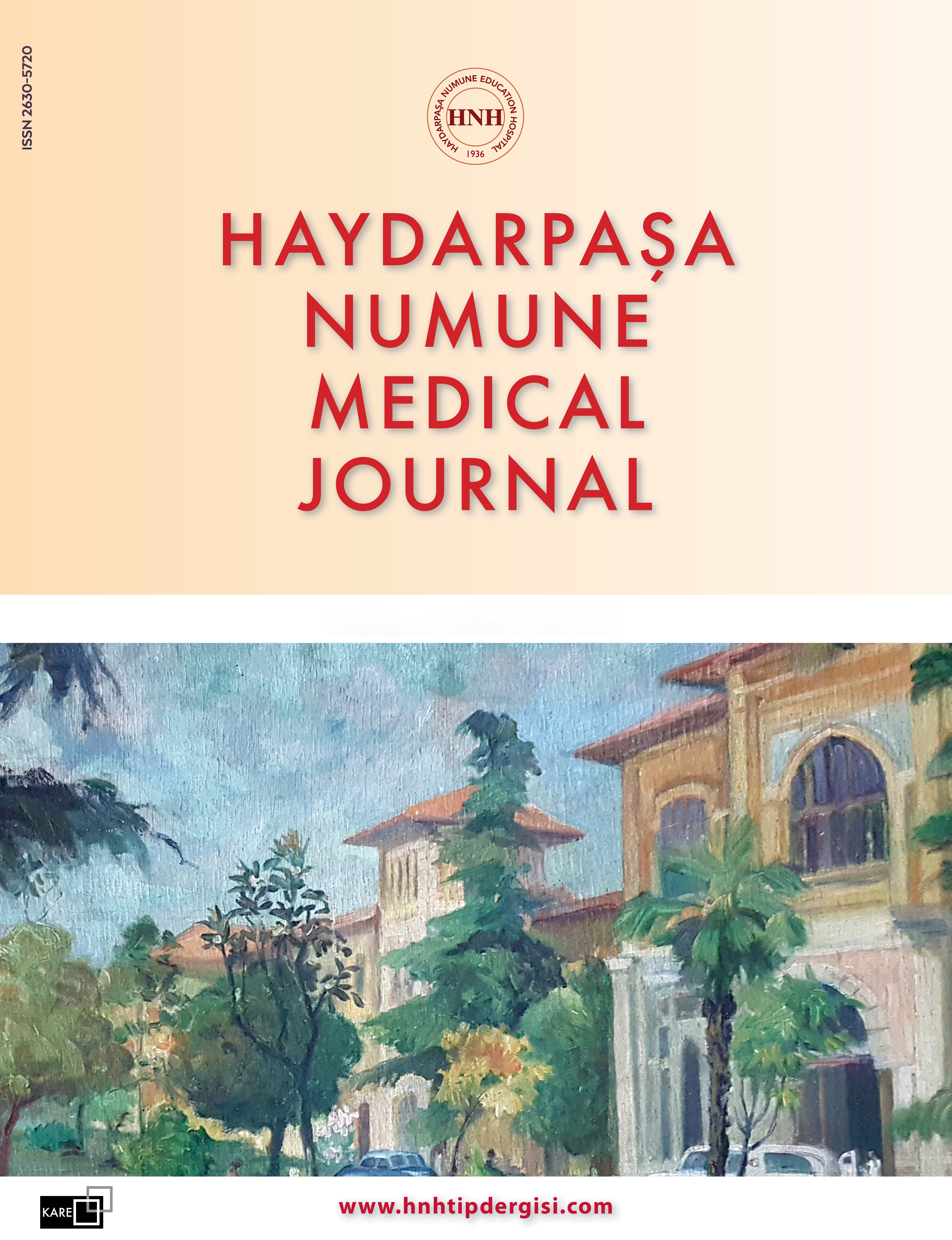Volume: 56 Issue: 3 - 2016
| RESEARCH ARTICLE | |
| 1. | Expression of PLIN2 and PLIN3 During The Different Phases of Estrous Cycle in Mouse İlknur Keskin, Turan Demircan, Nejda Bedri, Nadiye Köroğlu Pages 131 - 142 INTRODUCTION: Some primordial follicles which waits at the first meiotic prophase stage till puberty begins a recurring adventure with puberty every month under hormonal stimulation. During this process stromal cells differentiate into theca cells which are rich in terms of lipid droplets (LD). This process is very short, and completed an average of 4 days in mice. LDs, which are intracellular cytoplasmic structures, emerges as an energy source in many intracellular processes. Perilipin, a phosphorylation dependent protein, is localized to the surface of the oil droplets and protects LDs from the effect of the hormone-sensitive lipase. METHODS: 24 female mice that are sexually mature and having regular estrous cycle, were divided into 4 groups according to the vaginal smear results; proestrus, estrus, metestrus, and diestrus. Ovaries of the sacrificed mice were isolated. A single ovary was used for hematoxylin eosin sand PLIN2-PLIN3 double fluorescent staining. The other ovary was used for Western Blot analysis. RESULTS: According to the western blot results, PLIN2 expression was detected at most in diestrus stage, and these phases for PLIN3 are diestrus and proestrus. PLIN3 expression was found to be significantly high in comparison to the different cells in the same group in proestrus antral follicle oocytes (p <0.05). PLIN3 expression in estrus antral follicles is significantly higher than expressed PLIN3 amount in atretic follicles (p = 0.031). PLIN3 expression in diestrous phase for secondary follicular granulosa cells is significantly higher than proestrus (p = 0.000), estrus (p = 0.001) and metestrus (p = 0.023). PLIN3 expression in secondary follicles oocytes were significantly higher in diestrus phase than the the metestrus phase. PLIN3 expression in estrus phase for pre-antral follicle granulosa cells is significantly higher than proestrus (p=0,005), metestrus (p=0.045) and diestrus (p=0,025). PLIN3 expression level in atretic follicular granulosa cells was significantly higher in estrus phase than the proestrus phase (p = 0.023). DISCUSSION AND CONCLUSION: Ongoing events during the complex process of oocyte maturation, ovulation and fertilization stages require energy. By many studies, cross talking of pathways related to activation of oocytes and regulation of lipid mobilization has been demonstrated. Here, in this study, we exhibit the expression alterations of PLIN2 and PLIN3 in different phases or in diverse cells of the same phase during the estrous cycle. According to this data, we can conclude that, energy requirements of the oocyte and granulosa cells regulates the perilipin expression and maintenance of energy reserves. |
| 2. | Eleven Year Evaluation of Intraoperative Consultations in Üsküdar State Hospital Ayşe Nur İhvan, Leyla Çıtak Pages 143 - 146 INTRODUCTION: We aimed to evaluate the diagnostic value of frozen section, and to detect the factors causing erroneous diagnosis. METHODS: Frozen section and paraffin section reports of 167 patients who diagnosed between January 2005 and January 2016 in our institute were re-analyzed. RESULTS: Sensitivity of frozen section were; %92,6, specificity %97,8, positive predictive value %96, negative predictive value %96, effectiveness %96. DISCUSSION AND CONCLUSION: The sensitivity and specificity of frozen section were high and reliable in our institute. |
| 3. | Retrospective Analysis of Childhood Poisoning in Ümraniye Caner Araz, Mustafa Özgür Toklucu, Şirin Güven, Emin Pala, Tuğba Okur Pages 147 - 160 INTRODUCTION: Poisoning cases who had applied to Ümraniye Research and Training Hospital Pediatric Emergency Unit, below the age of 17, between January 2010- December 2012 were evaluated retrospectively. METHODS: RESULTS: Poisonings accounted for 0,3% of total pediatric emergency visits. Patients (n: 1129) aged between 1 months-16 years (5,37±5,02 years); 590 were female whereas 539 were male (1,09/1). Poisonings were more frequent under 5 years; 13 months- 4 years group consisted 39,4% and 0-12 months 21,7% of all cases. Accidental poisonings (82,5%) were more frequent than suicides (17,5%). Accidental poisonings were common in boys under 5 years though suicidal poisonings were common in 12-16 year old girls. Evaluation of the poisoning agents according to the age groups; drug ingestion became the most common poisoning reason except for 8-11 years group CO/NFIA exposures were more common. Poisonings occurred more frequently in March and in spring. Drugs ( %62) were the most common poisoning agents. Analgesics-antipyretic (21,17 %) and central nervous system medication (13,64%) poisonings were leading other drugs. CO/NFIA (16,8%) and caustic-corrosive substances (9,4%) were the most common non-pharmacological agents. Nausea- vomiting and tachycardia were the most frequent symptoms-signs; although the majority were asymptomatic. DISCUSSION AND CONCLUSION: Our study reflects the demographic properties of poisonings in our region and will contribute to undertake preventive measures for childhood poisoning in Turkey. |
| 4. | Retrospective Evaluation of the Patients Admitted to the Pediatric Cardiology Outpatient Clinic Esra Akyüz Özkan, Haşim Hüsrevşahi, Perihan Beyse Pages 161 - 167 INTRODUCTION: We aimed to evaluate the echocardiographic findings with complaints of patients admitted to our department. METHODS: A total of 2522 patients admitted to pediatric cardiology outpatient clinic between 2013-2015 were evaluated retrospectively. RESULTS: In all age groups it was revealed that normal echocardiogram was most common. The pathological findings in echocardiography were; patent foramen ovale (PFO) was the most common in newborns; atrial septal defect (ASD) in infants; ASD in 2-6 years and 6-12 years age group; and the mitral valve prolapse (MVP) in the 12-18 age group. While the murmur was the most frequent complaint of newborns, infants, 2-6 years and 6-12 years age group, chest pain was the most common for ages between 12-18 years. Normal echocardiography were determined in 72.1% of patients who admitted with a murmur, 77% of patients with chest pain; 65% of the patients with cyanosis; 40.5% of with palpitations and 71.9% with syncope. DISCUSSION AND CONCLUSION: The majority of patient, admitted to the pediatric cardiology clinic, determined as normal echocardiography. The most common anomaly was ASD. The most common complaint was heart murmur and majority of patients presenting with murmurs were in normal limits. |
| 5. | Posioning Resulting in Death in Intensive Care Medical Approach and Process Analysis Eyüp Kandemir, Habib Bostan, Muhammed Nabi Kantarcı Pages 168 - 174 INTRODUCTION: This study aimed to determine the relationship between different types of poisoning and death at crime scene or intensive care unit (ICU) to provide a guideline to prevent poisoning types resulting in death at the crime scene and to improve management of poisoning types resulting in death at emergency care units (ECU) and ICU. METHODS: A total of 103 cases of poisoning were investigated and classified into 14 groups (including mixed posioning) according to poison types. The relationship between types of poisoning, gender and treatment in ICU according to 7 different age groups was evaluated. RESULTS: Most frequent cause of poisoning was medical drugs (n=46; 44,7%). There is a statistically significant relationship between the cause of poisoning and those who receive an intensive care treatment (p=0,05). ICU treatment was significantly common in medical drug, amanita phalloides, methanol, organophosphate and other organic substance poisonings. Heroin, carbon monoxide and corrosive substance poisonings resulted in death at the scene or on the way to the hospital. DISCUSSION AND CONCLUSION: We conclude that precautions and efforts to prevent peoples contact with heroin, carbon monoxide and corrosive substances should be increased. The ICU treatment for those who were poisoned by medical drugs, amanita phalloides, methanol, organophosphate and other organic poisons should be improved. Presence of surgical transplantation teams in regions where mushroom poisoning (mycetism) is frequently seen could be beneficial. |
| 6. | Comparison of the Safety and Effectiveness of Flexible Ureterorenoscopy in Obese and Normal Weight Patient Eyüp Veli Küçük, Resul Sobay, Ahmet Tahra, Ahmet Bindayı, Fikret Fatih Önol Pages 175 - 180 INTRODUCTION: To compare the efficacy and the safety of flexible ureterorenoscopy (f-URS) in normal weihgted and obese patients with kidney stone. METHODS: We conducted a retrospective study in 75 normal weight and 28 obese patients who underwent a f-URS for kidney stones between 2010-2015. Success rates and complications in the obese patients (OP) group (BMI ≥30 kg/m2) were compared with the normal weight patients (NWP) (BMI <25 kg/m2). Patients were assesed with computed tomography-scan after 12 weeks of the procedure. The success was defined as a stone-free status (no or ≤5 mm residual stone) at the time of control. RESULTS: Twenty eight OP and 75 NWP were treated with f-URS. The overall success rate was 89.2% and 88% in the OP and NWP, respectively (p = 0.07). Postoperative morbidity was 8% in NWP and 7% in OP and it was similar in both groups. DISCUSSION AND CONCLUSION: Flexible ureterorenoscopy for kidney stones resulted in similar outcomes in NWP and OP. The overal morbidity is even equal between two groups. |
| 7. | Comparison of Spinal Versus General Anesthesia in Percutaneous Nephrolithotomy Eyüp Veli Küçük, Ümit Yıldırım, Ahmet Bindayı, Ahmet Tahra, Fikret Fatih Önol Pages 181 - 185 INTRODUCTION: To compare the efficacy and safety of spinal anesthesia and general anesthesia in percutaneous nephrolithotomy (PCNL) operation. METHODS: Between 2012 and 2015, 316 patients with kidney stones were treated with PCNL and evaluated retrospectively. Group 1 (n = 206) underwent general anesthesia and group 2 (n = 110) underwent spinal anesthesia. In group 1, PCNL was performed using standard technique under general anesthesia. In group 2, spinal anesthesia was done by injecting bupivacaine and fentanyl in spinal space between lumbar vertebra 3 and 4 in sitting position. Thereafter, a ureteral catheter was placed in lithotomy position following the checking of level of anesthesia. Then, PCNL was done by standard technique. Complications were recorded and analyzed. RESULTS: Mean stone size in group 1 and 2 was 32.2 ± 8.6 mm and 31.5 ± 8.2 mm, respectively. Operation time and decrease in hemoglobin level were similar between group 1 and group 2 (83.4 min vs 86 min, p= 0.31 and 0.9 g/dl vs 1 g/dl, p= 0.27, respectively). Intra-operative hypotension and postoperative headache were seen more in spinal group than the general anesthesia group with a statistically significant difference (P < 0.05). No neurologic complications were observed in both groups. Need to narcotic medications after the operation were 11.3 ± 3.1 mg and 7.6 ± 2.5 mg of morphine sulphate in group 1 and 2, respectively (P = 0.03). DISCUSSION AND CONCLUSION: Spinal anesthesia with combined bupivacaine and fentanyl is a safe and effective anesthetic method and had a comparable results regarding for PCNL. |
| 8. | Adverse Outcomes During Management Evaluated By Council of Forensic Medicine Habib Bostan, Ayşegül Ertan, Hüseyin Öz, Ziya Salihoğlu Pages 186 - 190 INTRODUCTION: Unsuccessful airway management at anesthesia practice can result with death or permanent brain damage. In this study we investigate the cases which are in dispute by the accusation of problematic airway control during anesthesia and that sent to Council of Forensic Medicine for expertise by court. METHODS: We retrospectively analyzed 37 case files between the years of 2006-2012 which were in dispute by the accusation of problematic airway control during anesthesia and that were evaluated by Council of Forensic Medicine. RESULTS: 27 (72.98%) of the cases were female, 10 (27.02%) of the cases were male. The distrubution of cases were as follows: 16 of cases (43.23%) were from Obstetrics and Gynecology, 7 of cases (18.91%) were from ENT, 6 of cases (16.21%) were from general surgery. The airway management in 27 cases (72.97%) were planned intervention, and 10 of the cases (27.03%) were urgent. While the preoperative preparations in 20 cases were adequately completed, the preparations in 17 cases were inadequtely completed. The number of cases that the anesthesia was performed by anesthesiologist or by anesthesia technicians with anesthesiologist supervision seems to higher than the cases that the anesthesia was performed by anesthesia technicians with surgeon supervision. It was found that most frequent adverse outcome was the difficult intubation with difficult ventilation (37.83%). Tracheal injuries ( 18.91 %) and esophageal injuries ( 10.81 %) followed this respectively. Patients who underwent tracheostomy because of difficult intubation was 16.21% of all cases. DISCUSSION AND CONCLUSION: It is necessary to be prepared for difficult airway possibility even if difficult intubation criteria arent detected. We suggest that training program on the recognization and management of difficult intubation and must be generalized. We predict that, with this generalized training program, the adverse outcomes and lawsuits might decrease. |
| REVIEW | |
| 9. | Postanesthetic Care Unit (PACU): Its Development and Signigicance Düriye Gül İnal, Dilek Ömür, Volkan Hancı Pages 191 - 196 The growing demand for intensive care units (ICU) in a wide range of patient groups may lead to limitations in capacity of ICU. These limitations may lead to delays in patient acceptance from the emergency departments and intensive care units along with increased mortality and morbidity; and may cause postponement of elective surgical operations which have postoperative intensive care indication. Reasons like higher costs of intensive care, increase in diversity and number of surgical procedures, increasing number of surgical interventions in elder patients with concomitant comorbidities required a special postoperative care unit. Postanesthetic care unit (PACU) has been established and developed to make the necessary interventions and the closer short-term intensive monitoring of patients after surgery and anesthesia. In this review the historical development and standards of PACU has been tried to summarized. |
| CASE REPORT | |
| 10. | Anesthesia Management of a Case with Melas Syndrome Derya Arslan Yurtlu, Murat Aksun, Bedriye Özdikiciler, Uğur Özgürbüz, Pınar Ayvat, Gülçin Önder Aran, Mehmet Kızılkaya Pages 197 - 200 MELAS syndrome is a disease which delevops as a result of point mutation on mitochondrial level and characterized with mitochondrial myopathy, lactic acidosis and stroke like episodes. Surgical and anesthesia procedures on MELAS syndrome diagnosed patients exhibites special features since these patients present tendency towards clinical situations such as hypothermia, metabolic acidosis and malign hyperthermia. Syndrome frequently co-exists with diabetes mellitus and cardiac conduction anomalies and this makes the situation more complicated. In this paper, anesthesia management for elective thyroidectomy operation in a MELAS syndrome case with co-existing diabetes mellitus, hypertrophic cardiomyopathy diagnoses is presented and anesthetic approach is discussed. |
| 11. | Two Cases With Benign Transient Hyperphosphatemia Esra Akyüz Özkan, Haşim Hüsrevşahi, Adem Yaşar, U. Aliye Geçit Pages 201 - 204 Bening transient hyperphosphatasemia is a clinic status seen in children generally younger than 5 years and characterized by serum alkaline phosphate (ALP) level higher than 3-50 times above the normal without evidence of liver and bone disease. The high alkaline phosphates level turn normal in 2-6 month. This article presents two cases that diagnosed elevated alkaline phosphate levels during routine tests, turn to normal spontaneously and had no liver and bone diseases. It is thought that this high level is due to viral infection. Benign transient hyperphosphatasemia is a condition that benign, transient and self limited. In the event of isolated high levels of ALP without clinical and laboratory findings, transient hyperphosphatasemia should be considered in the differential diagnosis. Patient can also be followed up in general pediatric clinics without referring to another center and performing unnecessary, richer tests. |
| 12. | Olgu Sunumu: Antibiyotik Etkenlere Karşı Spesifik Ige Araştırması Gülbu Işıtmangil Pages 205 - 208 Drug hypersensitivity; after use of some drugs is defined as the occurrence of undesired symptoms. Although it varies according to the individual; antibiotics, anti-inflammatory drugs, analgesic, antipyretic and also local and general anesthetics can lead to allergic reactions. Drug allergy rarely mediated by anaphylactic reaction can be fatal. Therefore a good history for diagnosis of drug allergy, examination, evaluation of clinical symptoms and allergy tests are required. In this case report; specific IgE antibody against 10 antibiotic agents have been investigated. |
















